About Us
 Director of the Public Relations Center: Junichi Watanabe
Director of the Public Relations Center: Junichi Watanabe
History
| 1994 | Public Information Office founded |
| 1995 | NAOJ website launched |
| April 1996 | Stargazing parties using the 50-cm Telescope for Public Outreach started |
| June 1998 | Public Information Office, New Objects Information Office, and Ephemeris Computation Office combined to form the Public Relations Center |
| July 2000 | Mitaka Campus Visitors’ Area opened |
| April 2004 | Library Unit and Public Relations Unit added to the Public Relations Center |
| 2011 | Repsold Transit Instrument registered as an important cultural property |
| 2014 | Office for Astronomy Outreach added to the Public Relations Center |
| April 2019 | Spectrum Management Office added to the Public Relations Center |
| April 2020 | Ishigakijima Astronomical Observatory added to the Public Relations Center |
| April 2022 | Time Keeping Office added to the Public Relations Center |
| November 2024 | Office of Historical Archives added to the Public Relations Center |
Public Relations Office
“A New View of the Universe” at Your Finger Tips
Head: Hitoshi Yamaoka
Activities
Internet Information Distribution
We manage the NAOJ website and continue stable, regular information-distribution. We also issue email magazines from time to time.
Press Releases
We release press releases and hold press conferences regarding NAOJ research results, etc.
Internet Live-Relays, Video Production
We broadcast lectures and notable heavenly phenomena, such as solar and lunar eclipses, live via the internet. We also produce videos.
Citizen Astronomy
By using data obtained from the observation facilities of NAOJ, such as the Subaru Telescope, we aim to bridge the gap between the public and researchers through research projects in which citizens can participate.
International Outreach
We disseminate information through press releases in English, and host booths at international meetings to build relationships with overseas journalists.
Outreach and Education Office
Making Astronomy Accessible to Everyone
Head: Hidehiko Agata
Activities
Department of Public Visits
The Outreach and Education Office conducts tours and special events at Mitaka Campus, which is the open research facility where the headquarters of NAOJ is located. See more
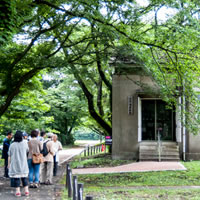
Public Visits
At NAOJ Mitaka Campus there are exhibition rooms open to the public to display the latest research and preserved observational instruments. Group tours are also offered.

4D2U Dome Theater Screenings (Japanese only)
We conduct screenings at the “4D2U Dome Theater,” where all-sky images envisioning the structure and evolution of the Universe based on the latest observational data and theoretical research results are projected on the dome screen.
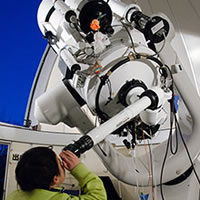
Regular Stargazing Parties
We hold regular stargazing parties (fixed capacity reservation system) in urban areas where the city lights hide the night sky, to look up at the Universe overhead and experience the appeal and wonder of astronomy.
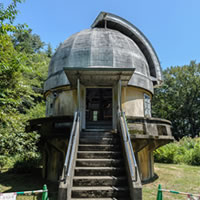
Events related to Cultural Properties
We conduct tours of the historical cultural-property facilities preserved in Mitaka Campus.
Inquires Department
The Outreach and Education Office answers questions related to astronomy and space from everyone, offering information to strengthen interest and understanding in astronomy. See more

Frequently Asked Questions (Japanese only)
This website offers answers to questions about first and foremost the Sun and Moon, but also covering all of the Universe, astronomy, the calendar, and NAOJ.
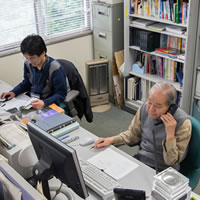
Astronomy Inquiries Telephone Service (Japanese only)
Questions about astronomical phenomena and the calendar that can’t be resolved through the “Frequently Asked Questions,” as well as other astronomy questions are answered via telephone or letters.
Department of Events and Education
The Outreach and Education Office plans and carries out a wide range of events for the purposes of astronomy outreach and education. See more
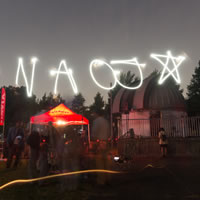
Mitaka Open House Day (Japanese only)
This department conducts the overall organization for the Mitaka Open House Day, a special public event carried out by NAOJ; the Institute of Astronomy, the University of Tokyo; the Astrobiology Center; and the Astronomical Science Program, The Graduate University for Advanced Studies, SOKENDAI.
Nationwide
This department implements nationwide outreach and education events from NAOJ Mitaka Campus.
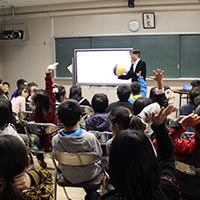
Fureai (Friendly) Astronomy (Japanese only)
Since 2010, we have conducted this program for NAOJ astronomers to visit elementary and junior-high schools across Japan and conduct classes.
Local Scale
We conduct outreach and education events in cooperation with NAOJ Mitaka Campus, City Hall, and related organizations.
Department of Content Development
In the Outreach and Education Office, we publish web content, including introductions of the outreach and education activities occurring in each department and reference material for enrich the experience and understanding of astronomical phenomena. We also work on producing printed matter, teaching materials, etc. See more
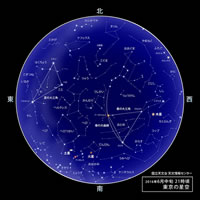
Astronomical Events Information (Japanese only)
We compile and publish the “Astronomical Events Information” which lists astronomical phenomena every for each month and explains viewing methods.
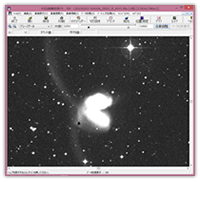
General Education (Makali`i)
We offer Makali`i, educational use data reduction software for FITS images obtained by researchers, free of charge.
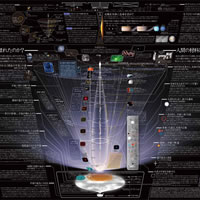
U Chu Zu “Diagram of the Universe” One for Every Home
We have made available on the internet the series of science posters marketed by the Japan Foundation of Public Communication on Science and Technology, which includes the NAOJ project “U Chu Zu.”

NAOJ Telescope Kit
We produce and sell telescope kits produced by the National Astronomical Observatory of Japan (NAOJ), aiming for both performance and low cost that can be used in educational settings.
Spectrum Management Office
Protection of the Environment for Radio Astronomy Observations
Head: Masaaki Hiramatsu
Activities
Conferences and Negotiations
We attend the meetings and conferences held by the MIC and ITU, and negotiate with other radio wave users to ensure that the operation of radio wave emitting devices does not negatively impact radio astronomy observations.
Investigation and Research
We investigate and research the effects of satellites that shine brightly by reflecting sunlight, and city lights to optical/infrared astronomy observation, and then work to protect the environments for astronomy.
Ephemeris Computation Office
Setting the Japanese Calendar
Head: Masato Katayama
Activities
Publication of the Calendar and Ephemeris
We publish information about various heavenly phenomena, such as the apparent positions of the Sun, Moon, and planets.
Release of the Reki Yoko
Particularly important information from the calendar and ephemeris is selected, and an outline of next year’s calendar is published in the first official gazette in February each year.
Compilation of the Calendrical Section of the Rika Nenpyo
As the most trusted “handbook of natural sciences” in Japan, the Rika Nenpyo, with its more than 90 years of history, is published through cooperation with numerous research institutes.
Library Unit
A Hub Library for Astronomy Research in Japan
Head: Misaki Yamaguchi
Activities
Storing Domestic and International Books on Astronomy and Related Fields
The main fields covered by the collection are astronomy and space sciences; earth sciences; mathematics; physics; and natural science and engineering.
Opening the Library to the General Public
On weekdays, members of the public are free to use the library. We have not only specialized books but also books for the general public.
Preservation and Exhibition of Important Historical Documents
We store about 3000 books, including, Japanese and Chinese books especially those preserved by the Tenmonkata (Astronomer for the Edo Shogunate), almanacs, and occidental books.
E-journal & E-book for use by NAOJ Researchers
We offer more than 5000 E-journal titles centered on astronomy, space-sciences, and related fields.
Publications Office
We introduce NAOJ through easy to understand publications.
Head: Hitoshi Yamaoka
Activities
Issuing the “Annual Report of NAOJ” and “Publications of NAOJ”
We produce the “Annual Report of NAOJ” and “Publications of NAOJ” as needed.
NAOJ News
Introduces research results and topics of NAOJ (in principle, quarterly)
Pamphlet
We update the Japanese pamphlet annually and the English pamphlet every 2 years.
Other Printed Materials
We produce calendars, posters, leaflets, and other assorted printed materials for public relations /outreach and education.
Office for Astronomy Outreach
Astronomy for Everyone, Everywhere — a joint project of the NAOJ and IAU
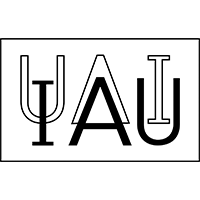
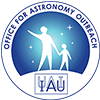
Head: Kelly Blumenthal
Activities
A Global Network with Local Reach
The OAO manages an international network of National Outreach Coordinators (NOCs), represented by over 120 countries and more than 300 team members. These NOCs are professional and amateuer astronomers, educators and astronomy enthusiasts, all with the mission of fulfilling the OAO’s goals on a regional and local level. Through cross-cultural collaborations, the NOCs build bridges to combat mutual challenges through astronomy communication.
Engaging the Public with Astronomy through Global Initiatives
The OAO facilitates one major Global Outreach Project each year, held in October — 100 Hours of Astronomy — which is a marathon of engagement activities linked together through global collaboration. In addition, we support three main Global Themes throughout the year: Women and Girls in Astronomy, Dark and Quiet Skies and Inclusive Astronomy Communication. We celebrate these Themes via dedicated activities on UN International Days, including Women and Girls in Astronomy (11 February) and Indigenous Peoples’ Day (9 August).
Professionalizing Astronomy Communication
The OAO is committed to professionalizing the field of astronomy communication, primarily through our series of activities under the umbrella of Communicating Astronomy with the Public (CAP).
The CAP Journal is the only fully open-access and peer-reviewed journal on astronomy communication. Now fully online, this journal provides the community with the resources and best practices needed to improve communications practices worldwide.
A conference series dedicated to sharing experiences and practical knowledge of astronomy communication, the CAP Conference takes place every two years as a collaborative effort of the OAO and the IAU Commission C2–Communicating Astronomy with the Public. Previous topics covered during CAP Conference include careers in astronomy communication and the science of science communication.
CAP Training provides professional development opportunities to astronomy communicators worldwide. This program will grow in the coming years to include accreditation, and easy-to-follow modules.
The OAO also manages the CAP Working Group on Inclusive Astronomy Communication. This Working Group provides essential guidance and resources on diversity, equity and inclusion, ultimately ensuring astronomy is made available to as many people as possible.
Time Keeping Office
Keeping the Japanese Time
Head: Tetsuharu Fuse
Activities
Maintaining and Disseminating Japan Central Standard Time
We maintain and disseminate Japan Central Standard Time through the operation of four cesium atomic clocks and an NTP sever.
Office of Historical Archives
New Insights from Historical Astronomical Research.
Head : Junichi Watanabe
Activities
Preservation, Organization, Utilization, and Public Release of the Historical Observational and Measuring Instruments
We preserve, organize, and utilize the numerous telescopes and measurement instruments remaining in NAOJ that have played historical roles.
Preservation, Organization, Utilization, and Public Release of Astrophotographic Glass Plates
We preserve, organize, and utilize photographic glasss plates remaining at NAOJ.
Ishigakijima Astronomical Observatory
Astronomy Outreach Using “the Other Subaru Telescope”
Head: Shogo Nagayama
Activities
Providing High-Quality Astronomy Images
We contribute to raising public awareness of astronomy by providing high-quality astronomy images and holding stargazing parties.
Education Through Astronomical Observations
Taking advantage of an ideal environment for astronomical observations, we offer educational programs such as school tours and hands-on observations.
Addressing the Latest Cosmic Mysteries
Collaborating with both domestic and overseas institutions, we perform cutting-edge observations of Solar System objects and transient objects using the Murikabushi Telescope.
Links
Our Websites and SNS Accounts
Our Official Websites
Events and Content Development
Special Websites
SNS
Contact
Public Relations Center
